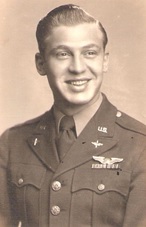 Contact met veteranen die gedurende de Tweede Wereldoorlog deel uitmaakten van een ‘air crew’ worden steeds zeldzamer. In het Brabantse Budel (gemeente Cranendonck) kregen we het bij de 70e herdenking van de bevrijding van Budel nog voor elkaar dat een Engelse en een Duitse veteraan elkaar innig verzoende. Tony Delahoy en Horst Mayer beiden voor langere tijd ingekwartierd in Budel onderhielden na 70 jaar nog steeds contact met Budel als dank voor de geborgenheid en warmte die ze 70 jaar geleden als jonge mannen (22 en 17 jaar) ondervonden. Beiden zo bleek later stonden met hun regimenten, medio juni 1944, lijnrecht tegen over elkaar in de bloedige slag om de Franse stad Caen (o.a nabij het vliegveld Carpiquet). Naast het feit dat er een boek werd uitgebracht was er aansluitend een tweedaagse belevingstocht georganiseerd, genaamd: ‘Sporen uit het Verleden’. De veteranen gingen, wellicht voor het laatst, meer dan tevreden naar huis. Een collega op mijn werk werd via het Eindhovens Dagblad hiervan op de hoogte gebracht en vertelde me dat hij gedurende zijn vakantie bij familie in New York nog in gesprek was geweest met een Amerikaanse ‘piloot’ die gedurende de Tweede Wereldoorlog had gevlogen. Zijn Neef Ed Waterschoot, die tegenover de ‘piloot’ woonde, zou voor zijn e-mail adres zorgen en contact was daarna snel gemaakt. Van neef Ed Waterschoot vernam ik vooraf dat zijn buurman niet veel vertelde over die tijd. Hij had wel een kistje voor zijn kleinkinderen. In dit kistje zo vertelde Ed zaten allerlei items die een tastbare herinnering waren aan die oorlogsjaren. Naast de gebruikelijke medailles zat er ook een bomscherf in. Tijdens een van zijn missies, zo had hij verteld, werd het vliegtuig zwaar beschoten door luchtafweer (flak). Een scherf vloog, tussen zijn benen door, in de tafel waarover hij zich als navigator over had gebogen. De scherf bleef echter onder in de tafel steken en na thuiskomst op de basis verliet hij als eerste het vliegtuig om even later met een schroevendraaier terug te komen om de scherf uit de tafel te ‘peuteren’. In mijn eerste mail had ik een 20-tal vragen opgenomen en de vraag of ik zijn verhaal mocht publiceren. Na een week kreeg ik antwoord en ik las een boeiend verhaal van een toentertijd jonge Italiaanse jongen. Eens te meer werd duidelijk welke risico’s deze jonge mannen liepen. Niet alleen vanwege de beschietingen maar vaak ook door kleine mankementen of vergissingen die zonder rigoureus ingrijpen tot de dood kon leidden. Hierbij het verhaal van Aldo Ricci, 92 jaar oud en woonachtig in Syracuse New York. Omdat de tekst letterlijk zo opgeschreven is door Aldo heb ik gemeend deze in het Engels te laten om de ‘kleur’ van het verhaal niet te beïnvloeden door een vertaling. Daarnaast ga ik er vanuit dat de SGLO-leden de Engelse taal beheersen.
Contact met veteranen die gedurende de Tweede Wereldoorlog deel uitmaakten van een ‘air crew’ worden steeds zeldzamer. In het Brabantse Budel (gemeente Cranendonck) kregen we het bij de 70e herdenking van de bevrijding van Budel nog voor elkaar dat een Engelse en een Duitse veteraan elkaar innig verzoende. Tony Delahoy en Horst Mayer beiden voor langere tijd ingekwartierd in Budel onderhielden na 70 jaar nog steeds contact met Budel als dank voor de geborgenheid en warmte die ze 70 jaar geleden als jonge mannen (22 en 17 jaar) ondervonden. Beiden zo bleek later stonden met hun regimenten, medio juni 1944, lijnrecht tegen over elkaar in de bloedige slag om de Franse stad Caen (o.a nabij het vliegveld Carpiquet). Naast het feit dat er een boek werd uitgebracht was er aansluitend een tweedaagse belevingstocht georganiseerd, genaamd: ‘Sporen uit het Verleden’. De veteranen gingen, wellicht voor het laatst, meer dan tevreden naar huis. Een collega op mijn werk werd via het Eindhovens Dagblad hiervan op de hoogte gebracht en vertelde me dat hij gedurende zijn vakantie bij familie in New York nog in gesprek was geweest met een Amerikaanse ‘piloot’ die gedurende de Tweede Wereldoorlog had gevlogen. Zijn Neef Ed Waterschoot, die tegenover de ‘piloot’ woonde, zou voor zijn e-mail adres zorgen en contact was daarna snel gemaakt. Van neef Ed Waterschoot vernam ik vooraf dat zijn buurman niet veel vertelde over die tijd. Hij had wel een kistje voor zijn kleinkinderen. In dit kistje zo vertelde Ed zaten allerlei items die een tastbare herinnering waren aan die oorlogsjaren. Naast de gebruikelijke medailles zat er ook een bomscherf in. Tijdens een van zijn missies, zo had hij verteld, werd het vliegtuig zwaar beschoten door luchtafweer (flak). Een scherf vloog, tussen zijn benen door, in de tafel waarover hij zich als navigator over had gebogen. De scherf bleef echter onder in de tafel steken en na thuiskomst op de basis verliet hij als eerste het vliegtuig om even later met een schroevendraaier terug te komen om de scherf uit de tafel te ‘peuteren’. In mijn eerste mail had ik een 20-tal vragen opgenomen en de vraag of ik zijn verhaal mocht publiceren. Na een week kreeg ik antwoord en ik las een boeiend verhaal van een toentertijd jonge Italiaanse jongen. Eens te meer werd duidelijk welke risico’s deze jonge mannen liepen. Niet alleen vanwege de beschietingen maar vaak ook door kleine mankementen of vergissingen die zonder rigoureus ingrijpen tot de dood kon leidden. Hierbij het verhaal van Aldo Ricci, 92 jaar oud en woonachtig in Syracuse New York. Omdat de tekst letterlijk zo opgeschreven is door Aldo heb ik gemeend deze in het Engels te laten om de ‘kleur’ van het verhaal niet te beïnvloeden door een vertaling. Daarnaast ga ik er vanuit dat de SGLO-leden de Engelse taal beheersen.
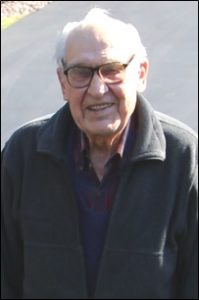 My name is Aldo Ricci, I am the neighbor of Ed Waterschoot, whose cousin Henri Waterschoot visited the States recently. I am 92 years old, and was born and raised in New York City of Italian parentage.
My name is Aldo Ricci, I am the neighbor of Ed Waterschoot, whose cousin Henri Waterschoot visited the States recently. I am 92 years old, and was born and raised in New York City of Italian parentage.
When the Japanese bombed Pearl Harbor, I was 18 years old and would be eligible to be drafted. Rather than wait to be called, I decided to enlist so that I could pick the service branch that I wanted I enlisted in the Aviation Cadet program, and started on the road to Pilot training. I was flying an airplane even before I ever learned to drive a car. My piloting skills were not up to what they were looking for, so I was sent to Navigation school, I graduated as a Navigator, 2nd Lt. and was assigned to the Arthur D. Barre – B-24 Bomber crew. After training in the States for a few months, we received orders to ferry a new B-24 from California to England. Our route was California to New Hampshire to Goose Bay, Canada to Iceland to England. This seemed like a huge task for a Navigator only a month out of Navigator school. However we made the trip successfully and delivered the plane to England. Our crew was then assigned to the 8th Air Force, 2nd Air Division, 453rd Bomb Group, stationed at Old Buckenham, Attleboro, England (photo below airfield).
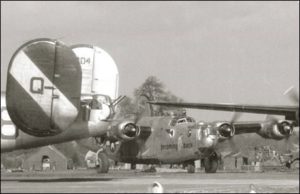 The 8th Air Force consisted of three divisions, 1st Div. 2nd Div. and 3rd Div. the 1st and 3rd Divisions flew B-17 Bombers, and the 2nd Air Division flew B-24 4 engine Bombers. The crew did some more training, and we flew our first Combat Mission in August 1944. shortly after the Normandy D-Day invasion.
The 8th Air Force consisted of three divisions, 1st Div. 2nd Div. and 3rd Div. the 1st and 3rd Divisions flew B-17 Bombers, and the 2nd Air Division flew B-24 4 engine Bombers. The crew did some more training, and we flew our first Combat Mission in August 1944. shortly after the Normandy D-Day invasion.
I flew 35 missions before the completion of my tour of duty. When we arrived in England a tour of duty consisted of 25 Missions, They then raised it to 30 missions and later to 35. The reason was a lack of replacement crews arriving, so our tour of duty was stretched out.
When I finished my 35 missions, I returned to the States and was scheduled for training in B-29 and a possible transfer to the Pacific Theater’, but V E day happened, and they started to discharge those with enough combat points, and I had more than enough to qualify. I was discharged from Service in May 1945.
My connection with Holland was only visual from the air, crossing the Zuider Zee area en route to targets in Germany. We only landed on the continent twice, once outside of Brussels because we were low on fuel, and another time at Chievres airfield, Belgium with 2 engines shot out, and not wanting to chance getting back to England over the Cold North Sea under those circumstances. The crew was ferried back to England in a few days, and the plane was left for repairs.
I can relate a few incidents that stay with me from my 35 mission tour of duty. Incident No. 1 – Oxygen is the lifeline to survival on a mission. The crew had to be on oxygen when we reached 10,000 ft. of altitude. We had oxygen checks every ten minutes, and each crew member reported their status. During one oxygen check, we got no response from the nose gunner, My Navigator position was directly behind the nose turret, and when I checked, his head was drooping. At first, I thought he had fallen asleep , but I opened the turret doors, and decided that he had passed out from lack of oxygen. I took off his oxygen mask, and applied mine to his face and he came to immediately. His oxygen supply had somehow been cut off. I alerted the pilot of the situation, and he immediately left. the Bomber formation to descend to a lower altitude. Rate of descent is about l000 ft. per minute, so to get to 10,000 ft. from 23,000 ft. would take 15 to 20 minutes, so we buddy breathed with my oxygen supply until we got down to a no oxygen level, It would have taken a few more minutes of delay, and we would have had a fatality on our hands (photo Liberator B-24).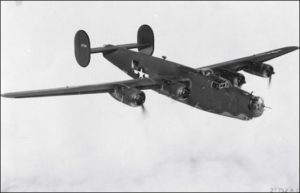
Incident No. 2 This incident concerned temperature, Flying at 23,000 ft. the outside temperature is about 52 Deg. Below zero Centigrade . In order to handle that temperature range, all crew members were outfitted with electrically heated suits covering our entire body. When I got to a point that I needed to use mine I found that mine was not working. The Flight Engineer checked all fuses, and tried another extension cord, but could not correct the situation. The Pilot asked if I wanted to abort the mission, but I advised that I would like to go as far as I could, It was a shallow penetration into Germany and I didn’t want to take ‘an easy one away’ from the crew. You only got credit for a mission if you dropped your bombs on target. so we tried to get to that point. I did a lot of foot stamping and arm motion to keep circulation going, and also attend to my Navigational duties, We were able to complete the bomb run and drop our bombs. As soon as we were clear of target. pilot left the formation, and we started to descend to a warmer altitude back to our base in England. In landing pattern, we shot red flares, indicating a need of medical assistance upon landing. We were met by Medics and I was examined for frostbite, and fortunately I was all right. We later deduced that the electrical pig tail from my suit, caught as I jumped out of the truck when I arrived at the plane, and this was what caused the electric suit failure. (photo: Colleague airman in front of my plane on several missions: DUMBO-The Flying Pachederm).
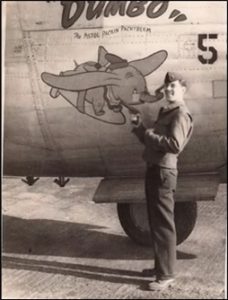
Incident No. 3 We were returning to our base from a mission with a lot of flak damage and our hydraulics shot out. The Flight Engineer had to manually crank down the landing gear. That also meant no brakes for slowing our landing speed. The pilot landed as short of the runway as he could, but our speed carried us to the end, and we went off the runway into a field. The nose wheel collapsed and the right engine propeller dug into the ground as we ploughed into the field. The danger was fire, but the Co-Pilot shut down all engines to minimize that danger. When plane stopped each crew member had an assigned escape route, My route was out the top hatch and onto the wing of the plane. The height to the ground was about 25 to 30 ft. but since there was still a chance of fire, I did not hesitate, and immediately jumped off the wing. Luckily, I landed without damage. The entire crew got out without injury and we were back to flying missions in 2 days,
Back in civilian life, I worked for a company for 30 years, selling Industrial Power Transmission Products, such as Belting, Conveyor Belting, V-Belts,
Gears and Bearings. At age 57 my company was bought out, and we had 2 sales forces. I was given a generous severance pay, but too young to retire. I was able to start my own business, Al Ricci Associates, Inc. selling the same product line to my old customers After 10 years, I sold the company to an associate, and they are still in business.
I am a member of the local American Legion Post, and a member of the 8th Air Force 2nd Air Division Association. The Association held yearly conventions across the States and I attended as many as I could. We had one in Norwhich, England in 2001 which I attended. At last year’s convention, a decision was made to shut down the group, because of lack of attendance due to age and loss of member.
The 2nd Air Division has supported a Living Memorial located at the Library in Norwhich, England, A wing of the library is devoted to the 2nd Air Division, and we have supported them with funds through the years, and at shutting down, we turned over our treasury to them, upwards of $200,000. If you want direst 8th Air Force data, they have a website at the library. www.2nd air.org.uk
My wife and I have been married for 65 years, and we have a Daughter and Son. One Great Grandson and two Great Grand children. Life has been good. When I started this story, I didn’t know I was going to be so long winded, but I trust that this might be some of the information that you were seeking Although my connection to Holland was only from the air, I enjoyed the view over Holland.
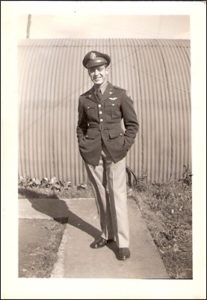 Afterthought: 35 Mission Combat Statistics
Afterthought: 35 Mission Combat Statistics
40,000 combat Miles (Estimated)
212:40 Combat Hours (Take off to Landing)
Returned to Base alone 12 times
Landed on Continent 2 times
3 engine returns 5 times
2 engine return 1 time
Crash Landend 1 time
Aldo Ricci is met zijn 92 jaar nog actief op het internet. Zodoende kon ik een mooi verslag van hem maken en u meenemen naar die oorlogsjaren die nu, 70 jaar geleden, nog steeds onze leden maar ook vele andere geïnteresseerden bezighoudt. Aldo Ricci laat in zijn laatste mail weten dat hij erg vereerd is om in de SGLO-magazine zijn verhaal te mogen vertellen. Mocht u nog aanvullingen of onderwerpen hebben die interessant zijn om te delen met Aldo Ricci zou ik dat graag vernemen op mijn e-mail: renevos1@chello.nl. Een film van 453rd Bomb Group en een fragment van zijn B-24 genaamd ‘Dumbo’ zijn te zien op de volgende link: http://wn.com/old_buckenham,_england,1945,_453rd_bomb_
group, _735_squadron.
Aldo Ricci overleed op 7 januari 2021 aan een natuurlijke dood op 98 jarige leeftijd:
‘Old Soldiers never die they simply fade away’
René Vos
Budel
